Abstract
Toxicology and carcinogenesis studies of benzene (CAS No. 71-43-2; greater than 99.7% pure) were conducted in groups of 60 F344/N rats and 60 B6C3F1 mice of each sex for each of three exposure doses and vehicle controls. These composite studies on benzene were designed and conducted because of large production volume and widespread human exposure, because of the epidemiologic association with leukemia, and because previous experiments were considered inadequate or inconclusive for determining carcinogenicity in laboratory animals. Using the results from 17-week studies, doses for the 2-year studies were selected based on clinical observations (tremors in higher dosed mice), on clinical pathologic findings (lymphoid depletion in rats and leukopenia in mice), and on body weight effects. Doses of 0, 50, 100, or 200 mg/kg body weight benzene in corn oil were administered by gavage to male rats, 5 days per week, for 103 weeks. Doses of 0, 25, 50, or 100 mg/kg benzene in corn oil were administered by gavage to female rats and to male and female mice for 103 weeks. Ten animals in each of the 16 groups were killed at 12 months, and necropsies were performed. Hematologic profiles were performed at 3-month intervals. For the 2-year studies, mean body weights of the top dose groups of male rats and of both sexes of mice were lower than those of the controls. Survivals of the top dose group of rats and mice of each sex were reduced; however, at week 92 for rats and week 91 for mice, survival was greater than 60% in all groups; most of the dosed animals that died before week 103 had neoplasia. Compound-related nonneoplastic or neoplastic effects on the hematopoietic system, Zymbal gland, forestomach, and adrenal gland were found both for rats and mice. Further, the oral cavity was affected in rats, and the lung, liver, Harderian gland, preputial gland, ovary, and mammary gland were affected in mice. Under the conditions of these 2-year gavage studies, there was clear evidence of carcinogenicity of benzene in male F344/N rats, female F344/N rats, male B6C3F1 mice, and female B6C3F1 mice. In male rats, benzene caused increased incidences of Zymbal gland carcinomas, squamous cell papillomas and squamous cell carcinomas of the oral cavity, and squamous cell papillomas and squamous cell carcinomas of the skin. In female rats, benzene caused increased incidences of Zymbal gland carcinomas and squamous cell papillomas and squamous cell carcinomas of the oral cavity.(ABSTRACT TRUNCATED AT 400 WORDS)
Full text
PDF

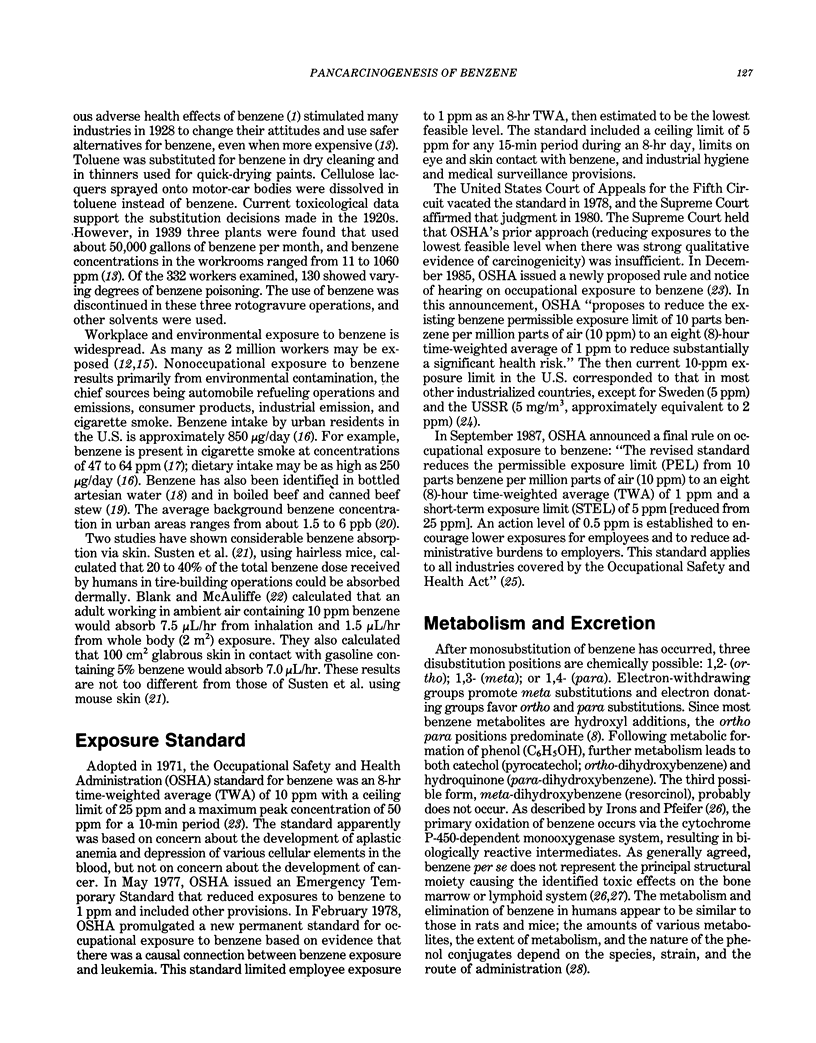
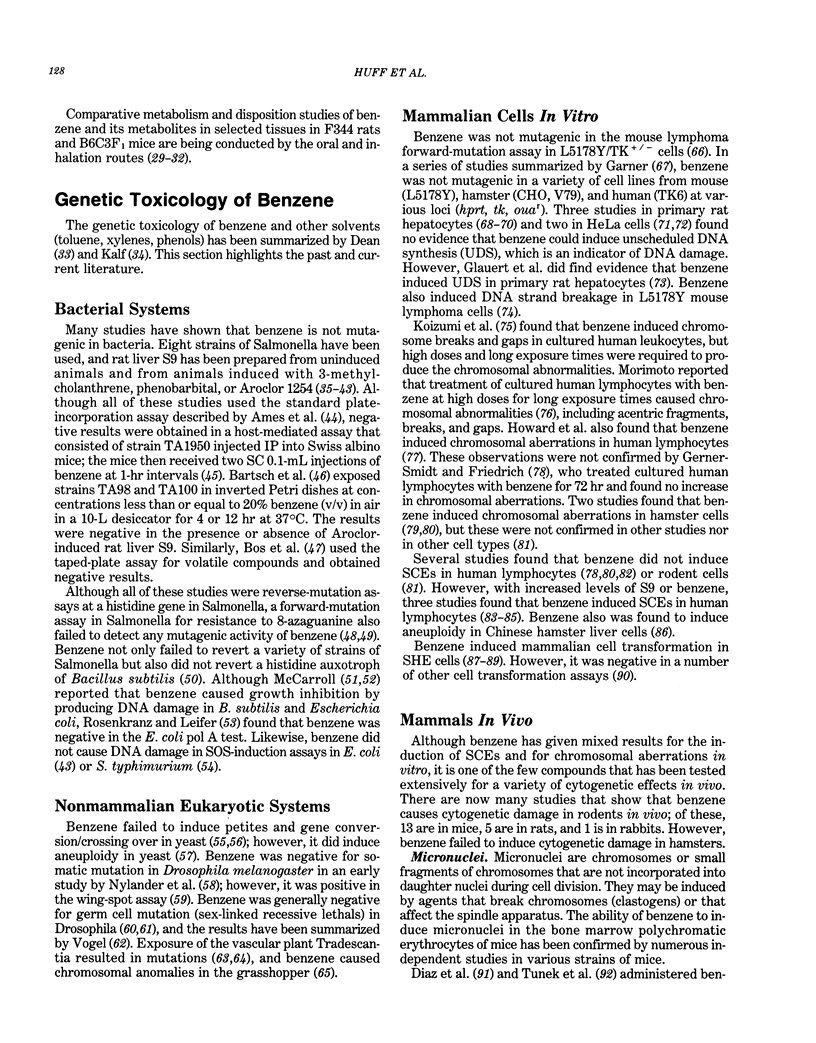













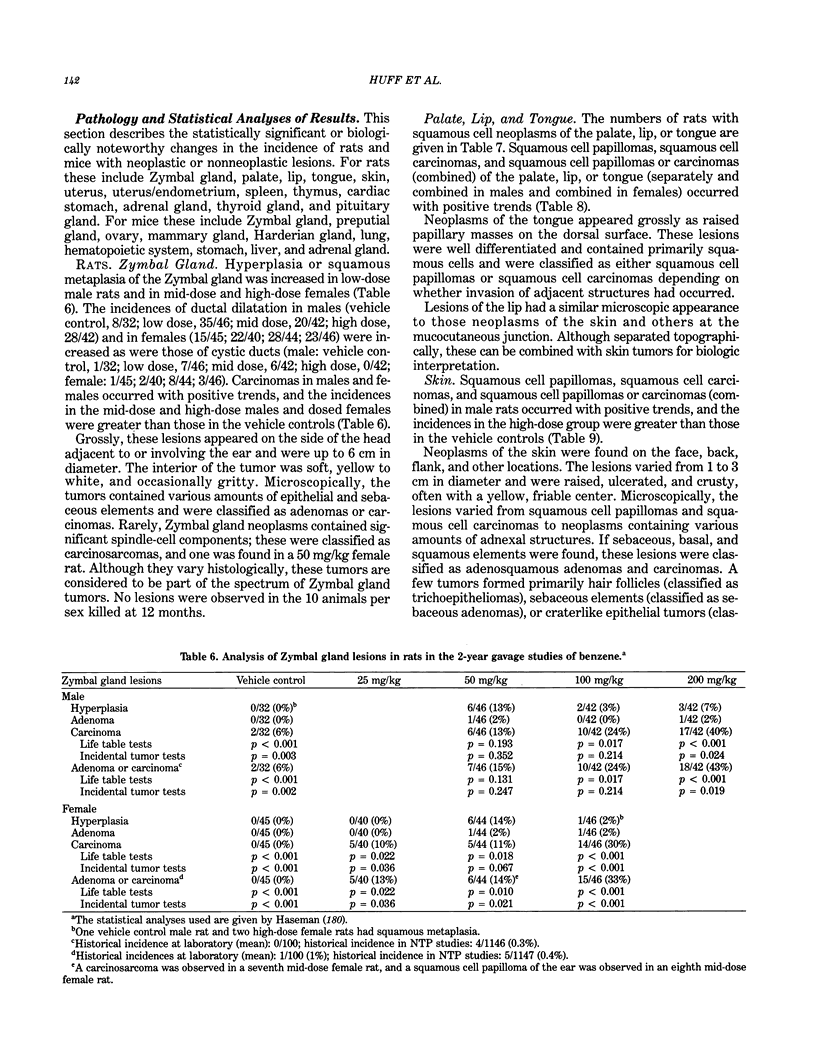

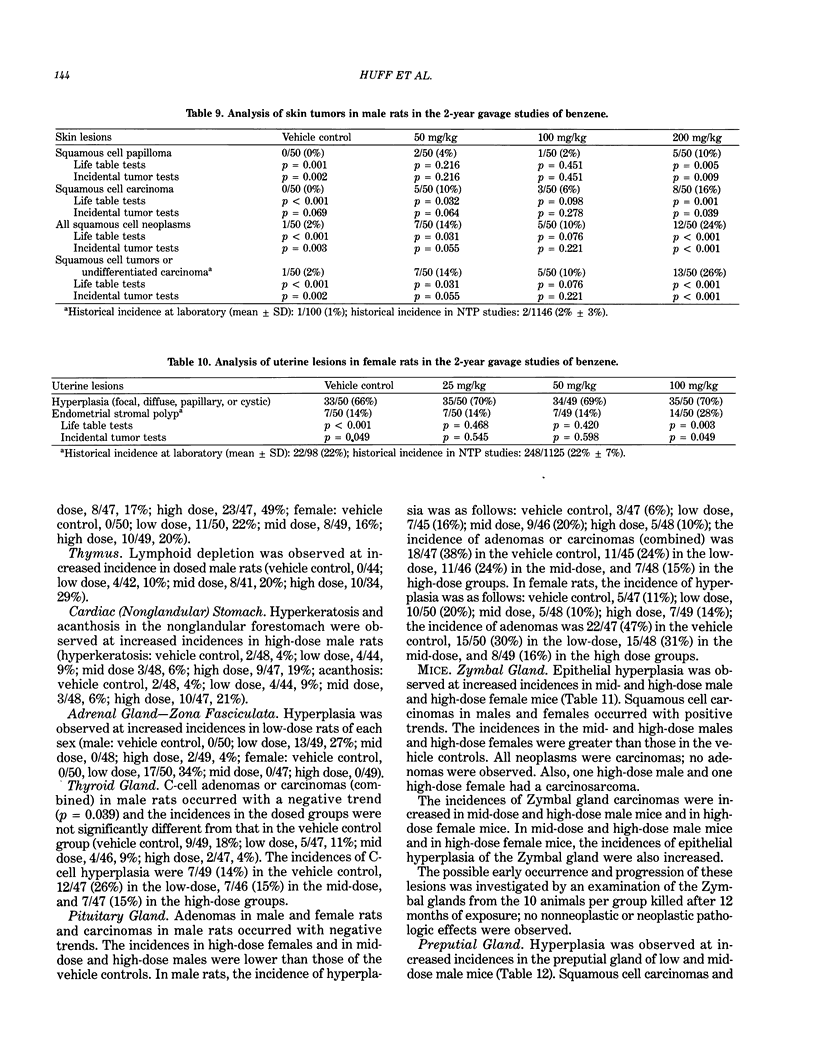
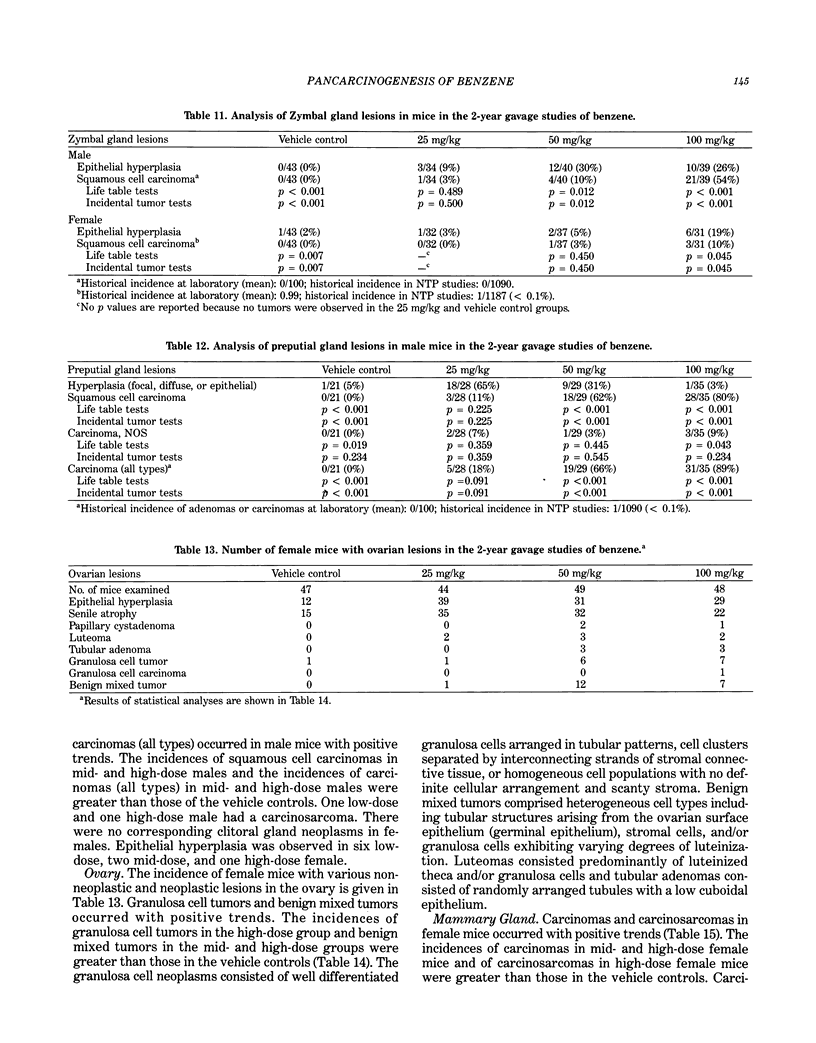
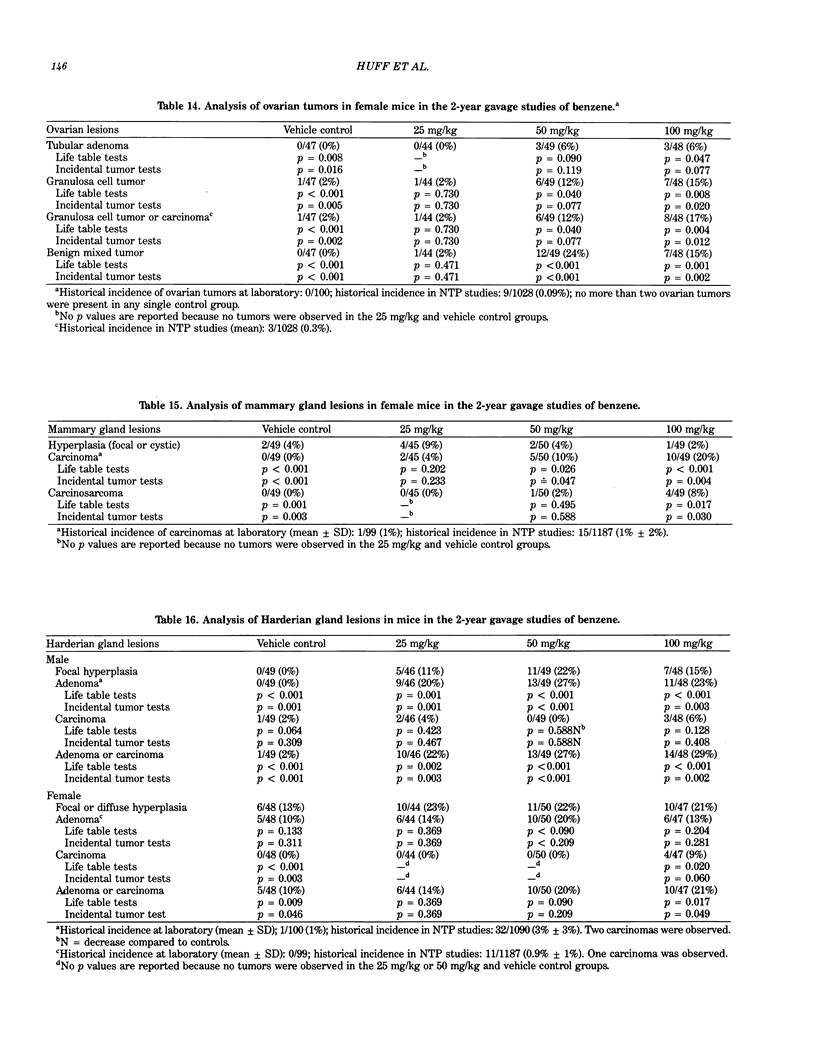


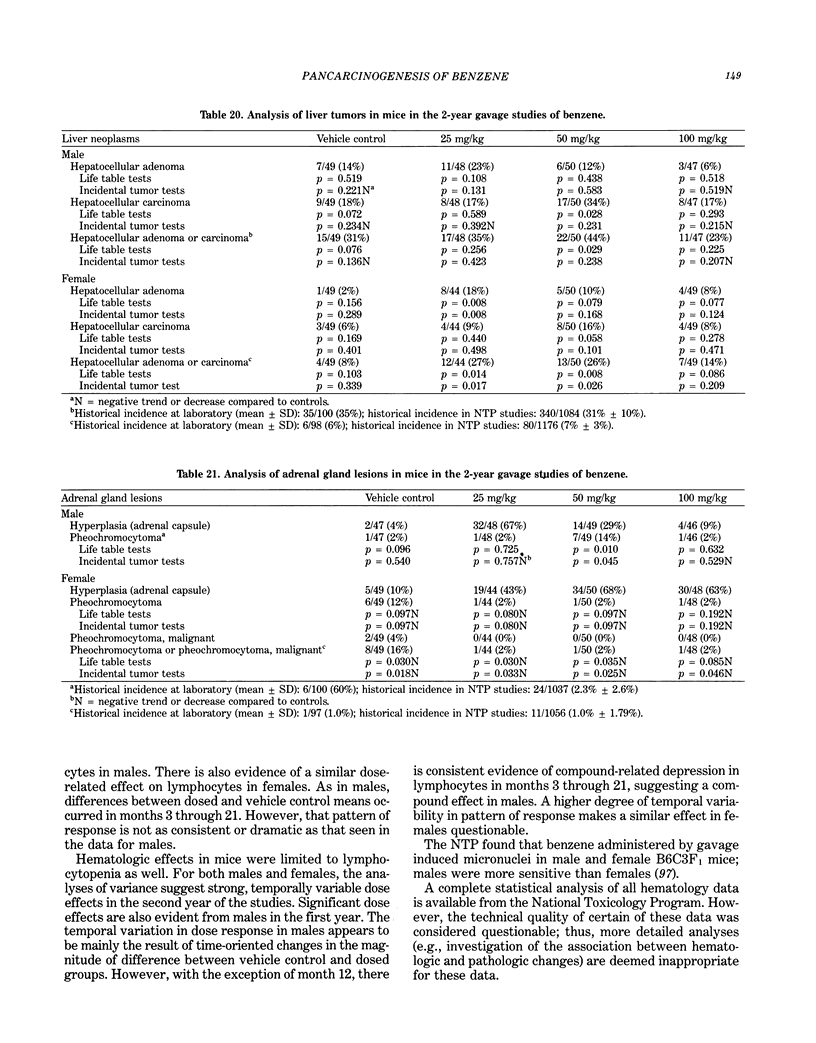




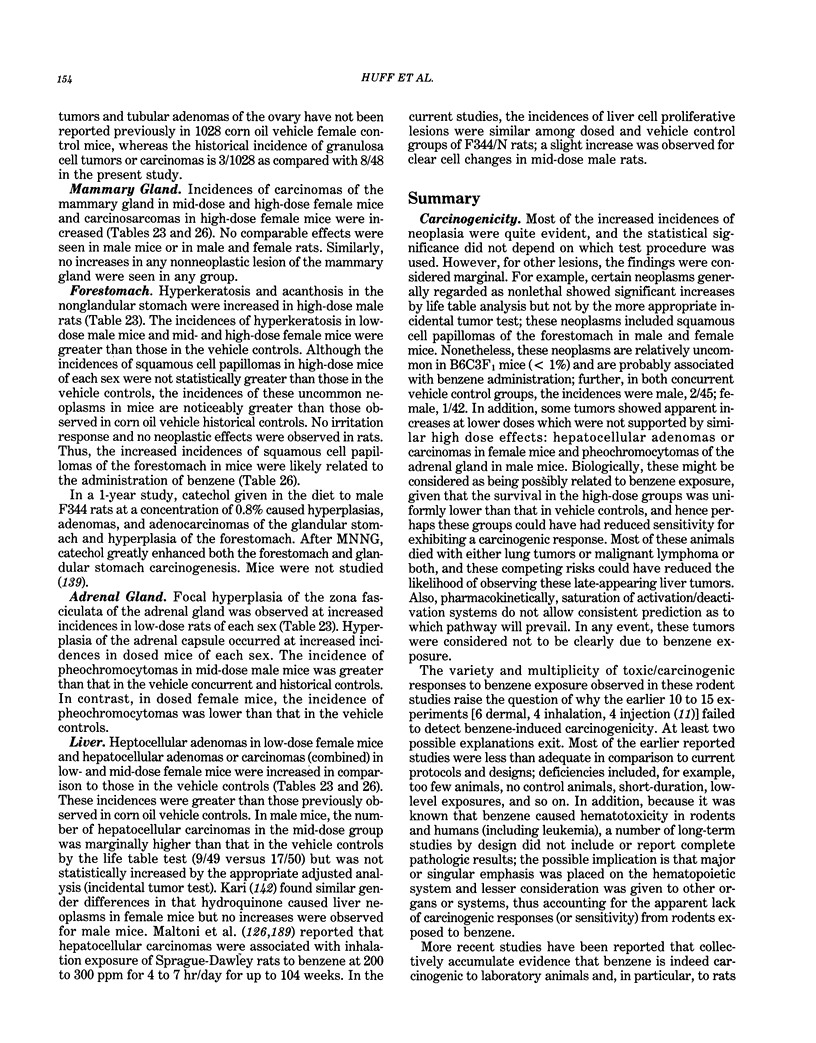




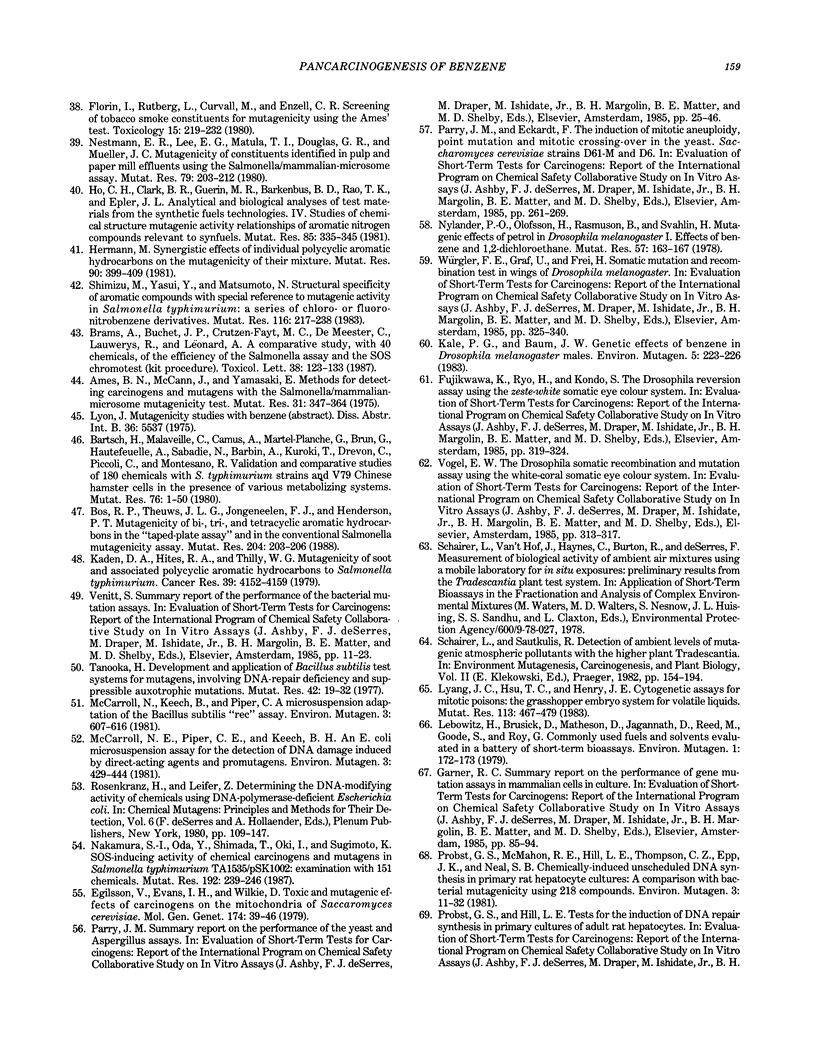




Selected References
These references are in PubMed. This may not be the complete list of references from this article.
- Aksoy M. Hematotoxicity and carcinogenicity of benzene. Environ Health Perspect. 1989 Jul;82:193–197. doi: 10.1289/ehp.8982193. [DOI] [PMC free article] [PubMed] [Google Scholar]
- Amacher D. E., Zelljadt I. The morphological transformation of Syrian hamster embryo cells by chemicals reportedly nonmutagenic to Salmonella typhimurium. Carcinogenesis. 1983;4(3):291–295. doi: 10.1093/carcin/4.3.291. [DOI] [PubMed] [Google Scholar]
- Ames B. N., Mccann J., Yamasaki E. Methods for detecting carcinogens and mutagens with the Salmonella/mammalian-microsome mutagenicity test. Mutat Res. 1975 Dec;31(6):347–364. doi: 10.1016/0165-1161(75)90046-1. [DOI] [PubMed] [Google Scholar]
- Anderson D., Richardson C. R. Issues relevant to the assessment of chemically induced chromosome damage in vivo and their relationship to chemical mutagenesis. Mutat Res. 1981 Nov;90(3):261–272. doi: 10.1016/0165-1218(81)90006-9. [DOI] [PubMed] [Google Scholar]
- Andrews L. S., Sasame H. A., Gillette J. R. 3H-Benzene metabolism in rabbit bone marrow. Life Sci. 1979 Aug 13;25(7):567–572. doi: 10.1016/0024-3205(79)90550-2. [DOI] [PubMed] [Google Scholar]
- Austin H., Delzell E., Cole P. Benzene and leukemia. A review of the literature and a risk assessment. Am J Epidemiol. 1988 Mar;127(3):419–439. doi: 10.1093/oxfordjournals.aje.a114820. [DOI] [PubMed] [Google Scholar]
- BOUTWELL R. K., BOSCH D. K. The tumor-promoting action of phenol and related compounds for mouse skin. Cancer Res. 1959 May;19(4):413–424. [PubMed] [Google Scholar]
- Bartsch H., Malaveille C., Camus A. M., Martel-Planche G., Brun G., Hautefeuille A., Sabadie N., Barbin A., Kuroki T., Drevon C. Validation and comparative studies on 180 chemicals with S. typhimurium strains and V79 Chinese hamster cells in the presence of various metabolizing systems. Mutat Res. 1980 Jul;76(1):1–50. doi: 10.1016/0165-1110(80)90002-0. [DOI] [PubMed] [Google Scholar]
- Blank I. H., McAuliffe D. J. Penetration of benzene through human skin. J Invest Dermatol. 1985 Dec;85(6):522–526. doi: 10.1111/1523-1747.ep12277325. [DOI] [PubMed] [Google Scholar]
- Bolcsak L. E., Nerland D. E. Inhibition of erythropoiesis by benzene and benzene metabolites. Toxicol Appl Pharmacol. 1983 Jul;69(3):363–368. doi: 10.1016/0041-008x(83)90259-4. [DOI] [PubMed] [Google Scholar]
- Bos R. P., Theuws J. L., Jongeneelen F. J., Henderson P. T. Mutagenicity of bi-, tri- and tetra-cyclic aromatic hydrocarbons in the "taped-plate assay" and in the conventional salmonella mutagenicity assay. Mutat Res. 1988 Feb;204(2):203–206. doi: 10.1016/0165-1218(88)90090-0. [DOI] [PubMed] [Google Scholar]
- Brams A., Buchet J. P., Crutzen-Fayt M. C., De Meester C., Lauwerys R., Léonard A. A comparative study, with 40 chemicals, of the efficiency of the Salmonella assay and the SOS chromotest (kit procedure). Toxicol Lett. 1987 Sep;38(1-2):123–133. doi: 10.1016/0378-4274(87)90120-2. [DOI] [PubMed] [Google Scholar]
- Brief R. S., Lynch J., Bernath T., Scala R. A. Benzene in the workplace. Am Ind Hyg Assoc J. 1980 Sep;41(9):616–623. doi: 10.1080/15298668091425392. [DOI] [PubMed] [Google Scholar]
- CARLSON A. J., BREWER N. R. Toxicity studies on hydroquinone. Proc Soc Exp Biol Med. 1953 Dec;84(3):684–688. doi: 10.3181/00379727-84-20751. [DOI] [PubMed] [Google Scholar]
- Choy W. N., MacGregor J. T., Shelby M. D., Maronpot R. R. Induction of micronuclei by benzene in B6C3F1 mice: retrospective analysis of peripheral blood smears from the NTP carcinogenesis bioassay. Mutat Res. 1985 May-Jun;143(1-2):55–59. doi: 10.1016/0165-7992(85)90105-8. [DOI] [PubMed] [Google Scholar]
- Chu K. C., Cueto C., Jr, Ward J. M. Factors in the evaluation of 200 National Cancer Institute carcinogen bioassays. J Toxicol Environ Health. 1981 Jul-Aug;8(1-2):251–280. doi: 10.1080/15287398109530068. [DOI] [PubMed] [Google Scholar]
- Cotruvo J. A., Simmon V. F., Spanggord R. J. Investigation of mutagenic effects of products of ozonation reactions in water. Ann N Y Acad Sci. 1978 Sep 29;298:124–140. doi: 10.1111/j.1749-6632.1977.tb19259.x. [DOI] [PubMed] [Google Scholar]
- Crebelli R., Conti G., Carere A. On the mechanism of mitotic segregation induction in Aspergillus nidulans by benzene hydroxy metabolites. Mutagenesis. 1987 May;2(3):235–238. doi: 10.1093/mutage/2.3.235. [DOI] [PubMed] [Google Scholar]
- Cronkite E. P., Bullis J., Inoue T., Drew R. T. Benzene inhalation produces leukemia in mice. Toxicol Appl Pharmacol. 1984 Sep 15;75(2):358–361. doi: 10.1016/0041-008x(84)90219-9. [DOI] [PubMed] [Google Scholar]
- Cronkite E. P., Drew R. T., Inoue T., Hirabayashi Y., Bullis J. E. Hematotoxicity and carcinogenicity of inhaled benzene. Environ Health Perspect. 1989 Jul;82:97–108. doi: 10.1289/ehp.898297. [DOI] [PMC free article] [PubMed] [Google Scholar]
- Davis D. L., Pope A. M. Reproductive risks of benzene: need for additional study. Toxicol Ind Health. 1986 Dec;2(4):445–451. doi: 10.1177/074823378600200407. [DOI] [PubMed] [Google Scholar]
- Dean B. J. Genetic toxicology of benzene, toluene, xylenes and phenols. Mutat Res. 1978;47(2):75–97. doi: 10.1016/0165-1110(78)90014-3. [DOI] [PubMed] [Google Scholar]
- Dean B. J. Recent findings on the genetic toxicology of benzene, toluene, xylenes and phenols. Mutat Res. 1985 Nov;154(3):153–181. doi: 10.1016/0165-1110(85)90016-8. [DOI] [PubMed] [Google Scholar]
- Decouflé P., Blattner W. A., Blair A. Mortality among chemical workers exposed to benzene and other agents. Environ Res. 1983 Feb;30(1):16–25. doi: 10.1016/0013-9351(83)90161-5. [DOI] [PubMed] [Google Scholar]
- Díaz M., Reiser A., Braier L., Diez J. Studies on benzene mutagenesis. I. The micronucleus test. Experientia. 1980 Mar 15;36(3):297–299. doi: 10.1007/BF01952286. [DOI] [PubMed] [Google Scholar]
- Egilsson V., Evans I. H., Wilkie D. Toxic and mutagenic effects of carcinogens on the mitochondria of Saccharomyces cerevisiae. Mol Gen Genet. 1979 Jul 2;174(1):39–46. doi: 10.1007/BF00433303. [DOI] [PubMed] [Google Scholar]
- Epler J. L., Larimer F. W., Rao T. K., Nix C. E., Ho T. Energy-related pollutants in the environment: use of short-term tests for mutagenicity in the isolation and identification of biohazards. Environ Health Perspect. 1978 Dec;27:11–20. doi: 10.1289/ehp.782711. [DOI] [PMC free article] [PubMed] [Google Scholar]
- Erexson G. L., Wilmer J. L., Kligerman A. D. Sister chromatid exchange induction in human lymphocytes exposed to benzene and its metabolites in vitro. Cancer Res. 1985 Jun;45(6):2471–2477. [PubMed] [Google Scholar]
- Erexson G. L., Wilmer J. L., Steinhagen W. H., Kligerman A. D. Induction of cytogenetic damage in rodents after short-term inhalation of benzene. Environ Mutagen. 1986;8(1):29–40. doi: 10.1002/em.2860080104. [DOI] [PubMed] [Google Scholar]
- Florin I., Rutberg L., Curvall M., Enzell C. R. Screening of tobacco smoke constituents for mutagenicity using the Ames' test. Toxicology. 1980;15(3):219–232. doi: 10.1016/0300-483x(80)90055-4. [DOI] [PubMed] [Google Scholar]
- Gad-El Karim M. M., Sadagopa Ramanujam V. M., Legator M. S. Correlation between the induction of micronuclei in bone marrow by benzene exposure and the excretion of metabolites in urine of CD-1 mice. Toxicol Appl Pharmacol. 1986 Sep 30;85(3):464–477. doi: 10.1016/0041-008x(86)90354-6. [DOI] [PubMed] [Google Scholar]
- Gad-El-Karim M. M., Harper B. L., Legator M. S. Modifications in the myeloclastogenic effect of benzene in mice with toluene, phenobarbital, 3-methylcholanthrene, Aroclor 1254 and SKF-525A. Mutat Res. 1984 Mar;135(3):225–243. doi: 10.1016/0165-1218(84)90126-5. [DOI] [PubMed] [Google Scholar]
- Garberg P., Akerblom E. L., Bolcsfoldi G. Evaluation of a genotoxicity test measuring DNA-strand breaks in mouse lymphoma cells by alkaline unwinding and hydroxyapatite elution. Mutat Res. 1988 Jun;203(3):155–176. doi: 10.1016/0165-1161(88)90101-x. [DOI] [PubMed] [Google Scholar]
- Gart J. J., Chu K. C., Tarone R. E. Statistical issues in interpretation of chronic bioassay tests for carcinogenicity. J Natl Cancer Inst. 1979 Apr;62(4):957–974. [PubMed] [Google Scholar]
- Gerner-Smidt P., Friedrich U. The mutagenic effect of benzene, toluene and xylene studied by the SCE technique. Mutat Res. 1978 Nov;58(2-3):313–316. doi: 10.1016/0165-1218(78)90024-1. [DOI] [PubMed] [Google Scholar]
- Gocke E., King M. T., Eckhardt K., Wild D. Mutagenicity of cosmetics ingredients licensed by the European Communities. Mutat Res. 1981 Oct;90(2):91–109. doi: 10.1016/0165-1218(81)90072-0. [DOI] [PubMed] [Google Scholar]
- Goldstein B. D. Benzene toxicity: a critical evaluation: hematotoxicity in humans. J Toxicol Environ Health Suppl. 1977;2:69–105. [PubMed] [Google Scholar]
- Goldstein B. D., Snyder C. A., Laskin S., Bromberg I., Albert R. E., Nelson N. Myelogenous leukemia in rodents inhaling benzene. Toxicol Lett. 1982 Oct;13(3-4):169–173. doi: 10.1016/0378-4274(82)90206-5. [DOI] [PubMed] [Google Scholar]
- Green J. D., Leong B. K., Laskin S. Inhaled benzene fetotoxicity in rats. Toxicol Appl Pharmacol. 1978 Oct;46(1):9–18. doi: 10.1016/0041-008x(78)90132-1. [DOI] [PubMed] [Google Scholar]
- Greenlee W. F., Gross E. A., Irons R. D. Relationship between benzene toxicity and the disposition of 14C-labelled benzene metabolites in the rat. Chem Biol Interact. 1981 Jan;33(2-3):285–299. doi: 10.1016/0009-2797(81)90047-8. [DOI] [PubMed] [Google Scholar]
- Grossenbacher J., Lob M. Etude longitudinale des effets á long terme d'une exposition professionnelle au benzène. Schweiz Med Wochenschr. 1982 Dec 11;112(50):1858–1859. [PubMed] [Google Scholar]
- Harper B. L., Legator M. S. Pyridine prevents the clastogenicity of benzene but not of benzo[a]pyrene or cyclophosphamide. Mutat Res. 1987 Jul;179(1):23–31. doi: 10.1016/0027-5107(87)90037-6. [DOI] [PubMed] [Google Scholar]
- Haseman J. K., Huff J. E., Rao G. N., Arnold J. E., Boorman G. A., McConnell E. E. Neoplasms observed in untreated and corn oil gavage control groups of F344/N rats and (C57BL/6N X C3H/HeN)F1 (B6C3F1) mice. J Natl Cancer Inst. 1985 Nov;75(5):975–984. doi: 10.1093/jnci/75.5.975. [DOI] [PubMed] [Google Scholar]
- Haseman J. K., Huff J. E., Zeiger E., McConnell E. E. Comparative results of 327 chemical carcinogenicity studies. Environ Health Perspect. 1987 Oct;74:229–235. doi: 10.1289/ehp.8774229. [DOI] [PMC free article] [PubMed] [Google Scholar]
- Haseman J. K., Huff J., Boorman G. A. Use of historical control data in carcinogenicity studies in rodents. Toxicol Pathol. 1984;12(2):126–135. doi: 10.1177/019262338401200203. [DOI] [PubMed] [Google Scholar]
- Haseman J. K. Statistical issues in the design, analysis and interpretation of animal carcinogenicity studies. Environ Health Perspect. 1984 Dec;58:385–392. doi: 10.1289/ehp.8458385. [DOI] [PMC free article] [PubMed] [Google Scholar]
- Hecht S. S., Carmella S., Mori H., Hoffmann D. A study of tobacco carcinogenesis. XX. Role of catechol as a major cocarcinogen in the weakly acidic fraction of smoke condensate. J Natl Cancer Inst. 1981 Jan;66(1):163–169. [PubMed] [Google Scholar]
- Hecht S. S., Thorne R. L., Maronpot R. R., Hoffmann D. A study of tobacco carcinogenesis. XIII. Tumor-promoting subfractions of the weakly acidic fraction. J Natl Cancer Inst. 1975 Dec;55(6):1329–1336. doi: 10.1093/jnci/55.6.1329. [DOI] [PubMed] [Google Scholar]
- Henderson R. F., Sabourin P. J., Bechtold W. E., Griffith W. C., Medinsky M. A., Birnbaum L. S., Lucier G. W. The effect of dose, dose rate, route of administration, and species on tissue and blood levels of benzene metabolites. Environ Health Perspect. 1989 Jul;82:9–17. doi: 10.1289/ehp.89829. [DOI] [PMC free article] [PubMed] [Google Scholar]
- Hermann M. Synergistic effects of individual polycyclic aromatic hydrocarbons on the mutagenicity of their mixtures. Mutat Res. 1981 Dec;90(4):399–409. doi: 10.1016/0165-1218(81)90062-8. [DOI] [PubMed] [Google Scholar]
- Hirose M., Kurata Y., Tsuda H., Fukushima S., Ito N. Catechol strongly enhances rat stomach carcinogenesis: a possible new environmental stomach carcinogen. Jpn J Cancer Res. 1987 Nov;78(11):1144–1149. [PubMed] [Google Scholar]
- Hite M., Pecharo M., Smith I., Thornton S. The effect of benzene in the micronucleus test. Mutat Res. 1980 Feb;77(2):149–155. doi: 10.1016/0165-1218(80)90132-9. [DOI] [PubMed] [Google Scholar]
- Ho C. H., Clark B. R., Guerin M. R., Barkenbus B. D., Rao T. K., Epler J. L. Analytical and biological analysis of test materials from the synthetic fuel technologies. Mutat Res. 1981 Oct;85(5):335–345. doi: 10.1016/0165-1161(81)90224-7. [DOI] [PubMed] [Google Scholar]
- Hudák A., Ungváry G. Embryotoxic effects of benzene and its methyl derivatives: toluene, xylene. Toxicology. 1978 Sep;11(1):55–63. doi: 10.1016/s0300-483x(78)90439-0. [DOI] [PubMed] [Google Scholar]
- Huff J. E., Eastin W., Roycroft J., Eustis S. L., Haseman J. K. Carcinogenesis studies of benzene, methyl benzene, and dimethyl benzenes. Ann N Y Acad Sci. 1988;534:427–440. doi: 10.1111/j.1749-6632.1988.tb30132.x. [DOI] [PubMed] [Google Scholar]
- Infante P. F. Leukemia among workers exposed to benzene. Tex Rep Biol Med. 1978;37:153–161. [PubMed] [Google Scholar]
- Infante P. F., White M. C. Benzene: epidemiologic observations of leukemia by cell type and adverse health effects associated with low-level exposure. Environ Health Perspect. 1983 Oct;52:75–82. doi: 10.1289/ehp.835275. [DOI] [PMC free article] [PubMed] [Google Scholar]
- Infante P. F., White M. C. Projections of leukemia risk associated with occupational exposure to benzene. Am J Ind Med. 1985;7(5-6):403–413. doi: 10.1002/ajim.4700070507. [DOI] [PubMed] [Google Scholar]
- Irons R. D., Dent J. G., Baker T. S., Rickert D. E. Benzene is metabolized and covalently bound in bone marrow in situ. Chem Biol Interact. 1980 May;30(2):241–245. doi: 10.1016/0009-2797(80)90130-1. [DOI] [PubMed] [Google Scholar]
- KISHIZAWA F. [Carcinogenic action of benzoquinone on the lung of mice by the experimental inhalation. II]. Gan. 1955 Sep;46(2-3):359–361. [PubMed] [Google Scholar]
- KISHIZAWA F. [Carcinogenic action of para-benzoquinone on the lung of mice by the experimental inhalation. 3]. Gan. 1956 Dec;47(3-4):601–603. [PubMed] [Google Scholar]
- KISHIZAWA F. [Carcinogenic action of para-benzoquinone on the lung of mice by the experimental inhalation]. Gan. 1954 Sep;45(2-3):389–391. [PubMed] [Google Scholar]
- Kaden D. A., Hites R. A., Thilly W. G. Mutagenicity of soot and associated polycyclic aromatic hydrocarbons to Salmonella typhimurium. Cancer Res. 1979 Oct;39(10):4152–4159. [PubMed] [Google Scholar]
- Kale P. G., Baum J. W. Genetic effects of benzene in Drosophila melanogaster males. Environ Mutagen. 1983;5(2):223–226. doi: 10.1002/em.2860050210. [DOI] [PubMed] [Google Scholar]
- Kalf G. F. Recent advances in the metabolism and toxicity of benzene. Crit Rev Toxicol. 1987;18(2):141–159. doi: 10.3109/10408448709089859. [DOI] [PubMed] [Google Scholar]
- Keller K. A., Snyder C. A. Mice exposed in utero to low concentrations of benzene exhibit enduring changes in their colony forming hematopoietic cells. Toxicology. 1986 Dec 15;42(2-3):171–181. doi: 10.1016/0300-483x(86)90007-7. [DOI] [PubMed] [Google Scholar]
- Kissling M., Speck B. Chromosome aberrations in experimental benzene intoxication. Helv Med Acta. 1971 Dec;36(1):59–66. [PubMed] [Google Scholar]
- Liang J. C., Hsu T. C., Henry J. E. Cytogenetic assays for mitotic poisons. The grasshopper embryo system for volatile liquids. Mutat Res. 1983 Oct;113(6):467–479. doi: 10.1016/0165-1161(83)90001-8. [DOI] [PubMed] [Google Scholar]
- Maltoni C., Ciliberti A., Cotti G., Conti B., Belpoggi F. Benzene, an experimental multipotential carcinogen: results of the long-term bioassays performed at the Bologna Institute of Oncology. Environ Health Perspect. 1989 Jul;82:109–124. doi: 10.1289/ehp.8982109. [DOI] [PMC free article] [PubMed] [Google Scholar]
- Maltoni C., Conti B., Cotti G., Belpoggi F. Experimental studies on benzene carcinogenicity at the Bologna Institute of Oncology: current results and ongoing research. Am J Ind Med. 1985;7(5-6):415–446. doi: 10.1002/ajim.4700070508. [DOI] [PubMed] [Google Scholar]
- Maltoni C., Scarnato C. First experimental demonstration of the carcinogenic effects of benzene; long-term bioassays on Sprague-Dawley rats by oral administration. Med Lav. 1979 Sep-Oct;70(5):352–357. [PubMed] [Google Scholar]
- McCarroll N. E., Piper C. E., Keech B. H. An E coli microsuspension assay for the detection of DNA damage induced by direct-acting agents and promutagens. Environ Mutagen. 1981;3(4):429–444. doi: 10.1002/em.2860030404. [DOI] [PubMed] [Google Scholar]
- McConnell E. E., Solleveld H. A., Swenberg J. A., Boorman G. A. Guidelines for combining neoplasms for evaluation of rodent carcinogenesis studies. J Natl Cancer Inst. 1986 Feb;76(2):283–289. [PubMed] [Google Scholar]
- Medinsky M. A., Sabourin P. J., Henderson R. F., Lucier G., Birnbaum L. S. Differences in the pathways for metabolism of benzene in rats and mice simulated by a physiological model. Environ Health Perspect. 1989 Jul;82:43–49. doi: 10.1289/ehp.898243. [DOI] [PMC free article] [PubMed] [Google Scholar]
- Mehlman M. A., Schreiner C. A., Mackerer C. R. Current status of benzene teratology: a brief review. J Environ Pathol Toxicol. 1980 Nov;4(5-6):123–131. [PubMed] [Google Scholar]
- Meyne J., Legator M. S. Sex-related differences in cytogenetic effects of benzene in the bone marrow of Swiss mice. Environ Mutagen. 1980;2(1):43–50. doi: 10.1002/em.2860020107. [DOI] [PubMed] [Google Scholar]
- Morimoto K. Induction of sister chromatid exchanges and cell division delays in human lymphocytes by microsomal activation of benzene. Cancer Res. 1983 Mar;43(3):1330–1334. [PubMed] [Google Scholar]
- Morimoto K., Wolff S. Increase of sister chromatid exchanges and perturbations of cell division kinetics in human lymphocytes by benzene metabolites. Cancer Res. 1980 Apr;40(4):1189–1193. [PubMed] [Google Scholar]
- Morimoto K., Wolff S., Koizumi A. Induction of sister-chromatid exchanges in human lymphocytes by microsomal activation of benzene metabolites. Mutat Res. 1983 Mar;119(3):355–360. doi: 10.1016/0165-7992(83)90185-9. [DOI] [PubMed] [Google Scholar]
- Nakamura S. I., Oda Y., Shimada T., Oki I., Sugimoto K. SOS-inducing activity of chemical carcinogens and mutagens in Salmonella typhimurium TA1535/pSK1002: examination with 151 chemicals. Mutat Res. 1987 Dec;192(4):239–246. doi: 10.1016/0165-7992(87)90063-7. [DOI] [PubMed] [Google Scholar]
- Nebert D. W., Jensen N. M. The Ah locus: genetic regulation of the metabolism of carcinogens, drugs, and other environmental chemicals by cytochrome P-450-mediated monooxygenases. CRC Crit Rev Biochem. 1979;6(4):401–437. doi: 10.3109/10409237909105427. [DOI] [PubMed] [Google Scholar]
- Nestmann E. R., Lee E. G., Matula T. I., Douglas G. R., Mueller J. C. Mutagenicity of constituents identified in pulp and paper mill effluents using the Salmonella/mammalian-microsome assay. Mutat Res. 1980 Nov;79(3):203–212. doi: 10.1016/0165-1218(80)90067-1. [DOI] [PubMed] [Google Scholar]
- Neuberger A., Smith R. L. Richard Tecwyn Williams: the man, his work, his impact. Drug Metab Rev. 1983;14(3):559–607. doi: 10.3109/03602538308991399. [DOI] [PubMed] [Google Scholar]
- Nylander P. O., Olofsson H., Rasmuson B., Svahlin H. Mutagenic effects of petrol in Drosophila melanogaster I. Effects of benzene and 1,2-dichloroethane. Mutat Res. 1978 May;57(2):163–167. doi: 10.1016/0027-5107(78)90263-4. [DOI] [PubMed] [Google Scholar]
- Ott M. G., Townsend J. C., Fishbeck W. A., Langner R. A. Mortality among individuals occupationally exposed to benzene. Arch Environ Health. 1978 Jan-Feb;33(1):3–10. doi: 10.1080/00039896.1978.10667299. [DOI] [PubMed] [Google Scholar]
- PARKE D. V., WILLIAMS R. T. Studies in detoxication. XLIX. The metabolism of benzene containing (14C1) benzene. Biochem J. 1953 May;54(2):231–238. doi: 10.1042/bj0540231. [DOI] [PMC free article] [PubMed] [Google Scholar]
- Pellack-Walker P., Blumer J. L. DNA damage in L5178YS cells following exposure to benzene metabolites. Mol Pharmacol. 1986 Jul;30(1):42–47. [PubMed] [Google Scholar]
- Pellack-Walker P., Walker J. K., Evans H. H., Blumer J. L. Relationship between the oxidation potential of benzene metabolites and their inhibitory effect on DNA synthesis in L5178YS cells. Mol Pharmacol. 1985 Dec;28(6):560–566. [PubMed] [Google Scholar]
- Pohl R. J., Fouts J. R. Cytochrome P-450-dependent xenobiotic metabolizing activity in Zymbal's gland, a specialized sebaceous gland of rodents. Cancer Res. 1983 Aug;43(8):3660–3662. [PubMed] [Google Scholar]
- Post G. B., Snyder R., Kalf G. F. Inhibition of RNA synthesis and interleukin-2 production in lymphocytes in vitro by benzene and its metabolites, hydroquinone and p-benzoquinone. Toxicol Lett. 1985 Dec;29(2-3):161–167. doi: 10.1016/0378-4274(85)90037-2. [DOI] [PubMed] [Google Scholar]
- Probst G. S., McMahon R. E., Hill L. E., Thompson C. Z., Epp J. K., Neal S. B. Chemically-induced unscheduled DNA synthesis in primary rat hepatocyte cultures: a comparison with bacterial mutagenicity using 218 compounds. Environ Mutagen. 1981;3(1):11–32. doi: 10.1002/em.2860030103. [DOI] [PubMed] [Google Scholar]
- Proctor B. L., Gaulden M. E., Dowd M. A. Reactivity and fate of benzene and formaldehyde in culture medium with and without fetal calf serum; relevance to in vitro mutagenicity testing. Mutat Res. 1986 May;160(3):259–266. doi: 10.1016/0027-5107(86)90136-3. [DOI] [PubMed] [Google Scholar]
- ROE F. J., SALAMAN M. H. Further studies on incomplete carcinogenesis: triethylene melamine (T.E.M.), 1,2-benzanthracene and beta-propiolactone, as initiators of skin tumour formation in the mouse. Br J Cancer. 1955 Mar;9(1):177–203. doi: 10.1038/bjc.1955.14. [DOI] [PMC free article] [PubMed] [Google Scholar]
- Rickert D. E., Baker T. S., Bus J. S., Barrow C. S., Irons R. D. Benzene disposition in the rat after exposure by inhalation. Toxicol Appl Pharmacol. 1979 Jul;49(3):417–423. doi: 10.1016/0041-008x(79)90441-1. [DOI] [PubMed] [Google Scholar]
- Rinsky R. A., Smith A. B., Hornung R., Filloon T. G., Young R. J., Okun A. H., Landrigan P. J. Benzene and leukemia. An epidemiologic risk assessment. N Engl J Med. 1987 Apr 23;316(17):1044–1050. doi: 10.1056/NEJM198704233161702. [DOI] [PubMed] [Google Scholar]
- Rithidech K., Au W. W., Ramanujam V. M., Whorton E. B., Jr, Legator M. S. Induction of chromosome aberrations in lymphocytes of mice after subchronic exposure to benzene. Mutat Res. 1987 Jun;188(2):135–140. doi: 10.1016/0165-1218(87)90102-9. [DOI] [PubMed] [Google Scholar]
- Rusch G. M., Leong B. K., Laskin S. Benzene metabolism. J Toxicol Environ Health Suppl. 1977;2:23–36. [PubMed] [Google Scholar]
- SALAMAN M. H., GLENDENNING O. M. Tumour promotion in mouse skin by sclerosing agents. Br J Cancer. 1957 Sep;11(3):434–444. doi: 10.1038/bjc.1957.51. [DOI] [PMC free article] [PubMed] [Google Scholar]
- Sabourin P. J., Bechtold W. E., Birnbaum L. S., Lucier G., Henderson R. F. Differences in the metabolism and disposition of inhaled [3H]benzene by F344/N rats and B6C3F1 mice. Toxicol Appl Pharmacol. 1988 Jun 15;94(1):128–140. doi: 10.1016/0041-008x(88)90343-2. [DOI] [PubMed] [Google Scholar]
- Sabourin P. J., Chen B. T., Lucier G., Birnbaum L. S., Fisher E., Henderson R. F. Effect of dose on the absorption and excretion of [14C]benzene administered orally or by inhalation in rats and mice. Toxicol Appl Pharmacol. 1987 Feb;87(2):325–336. doi: 10.1016/0041-008x(87)90294-8. [DOI] [PubMed] [Google Scholar]
- Sarto F., Cominato I., Pinton A. M., Brovedani P. G., Merler E., Peruzzi M., Bianchi V., Levis A. G. A cytogenetic study on workers exposed to low concentrations of benzene. Carcinogenesis. 1984 Jun;5(6):827–832. doi: 10.1093/carcin/5.6.827. [DOI] [PubMed] [Google Scholar]
- Selkirk J. K., Croy R. G., Whitlock J. P., Jr, Gelboin H. V. In vitro metabolism of benzo(a)pyrene by human liver microsomes and lymphocytes. Cancer Res. 1975 Dec;35(12):3651–3655. [PubMed] [Google Scholar]
- Shahin M. M., Fournier F. Suppression of mutation induction and failure to detect mutagenic activity with athabasca tar sand fractions. Mutat Res. 1978 Sep;58(1):29–34. doi: 10.1016/0165-1218(78)90092-7. [DOI] [PubMed] [Google Scholar]
- Shimizu M., Yasui Y., Matsumoto N. Structural specificity of aromatic compounds with special reference to mutagenic activity in Salmonella typhimurium--a series of chloro- or fluoro-nitrobenzene derivatives. Mutat Res. 1983 Mar;116(3-4):217–238. doi: 10.1016/0165-1218(83)90060-5. [DOI] [PubMed] [Google Scholar]
- Siou G., Conan L., el Haitem M. Evaluation of the clastogenic action of benzene by oral administration with 2 cytogenetic techniques in mouse and Chinese hamster. Mutat Res. 1981 Nov;90(3):273–278. doi: 10.1016/0165-1218(81)90007-0. [DOI] [PubMed] [Google Scholar]
- Snyder R., Jowa L., Witz G., Kalf G., Rushmore T. Formation of reactive metabolites from benzene. Arch Toxicol. 1987;60(1-3):61–64. doi: 10.1007/BF00296948. [DOI] [PubMed] [Google Scholar]
- Snyder R., Kocsis J. J. Current concepts of chronic benzene toxicity. CRC Crit Rev Toxicol. 1975 Jun;3(3):265–288. doi: 10.3109/10408447509079860. [DOI] [PubMed] [Google Scholar]
- Stich H. F., Rosin M. P., Wu C. H., Powrie W. D. The action of transition metals on the genotoxicity of simple phenols, phenolic acids and cinnamic acids. Cancer Lett. 1981 Dec;14(3):251–260. doi: 10.1016/0304-3835(81)90151-8. [DOI] [PubMed] [Google Scholar]
- Styles J. A., Richardson C. R. Cytogenetic effects of benzene: dosimetric studies on rats exposed to benzene vapour. Mutat Res. 1984 Mar;135(3):203–209. doi: 10.1016/0165-1218(84)90123-x. [DOI] [PubMed] [Google Scholar]
- Tanooka H. Development and applications of Bacillus subtilis test systems for mutagens, involving DNA-repair deficiency and suppressible auxotrophic mutations. Mutat Res. 1977 Jan;42(1):19–31. doi: 10.1016/s0027-5107(77)80004-3. [DOI] [PubMed] [Google Scholar]
- Tice R. R., Costa D. L., Drew R. T. Cytogenetic effects of inhaled benzene in murine bone marrow: induction of sister chromatid exchanges, chromosomal aberrations, and cellular proliferation inhibition in DBA/2 mice. Proc Natl Acad Sci U S A. 1980 Apr;77(4):2148–2152. doi: 10.1073/pnas.77.4.2148. [DOI] [PMC free article] [PubMed] [Google Scholar]
- Topham J. C. Do induced sperm-head abnormalities in mice specifically identify mammalian mutagens rather than carcinogens? Mutat Res. 1980 Oct;74(5):379–387. doi: 10.1016/0165-1161(80)90195-8. [DOI] [PubMed] [Google Scholar]
- Tunek A., Högstedt B., Olofsson T. Mechanism of benzene toxicity. Effects of benzene and benzene metabolites on bone marrow cellularity, number of granulopoietic stem cells and frequency of micronuclei in mice. Chem Biol Interact. 1982 Mar 15;39(2):129–138. doi: 10.1016/0009-2797(82)90116-8. [DOI] [PubMed] [Google Scholar]
- Tunek A., Platt K. L., Bentley P., Oesch F. Microsomal metabolism of benzene to species irreversibly binding to microsomal protein and effects of modifications of this metabolism. Mol Pharmacol. 1978 Sep;14(5):920–929. [PubMed] [Google Scholar]
- Tunek A., Platt K. L., Przybylski M., Oesch F. Multi-step metabolic activation of benzene. Effect of superoxide dismutase on covalent binding to microsomal macromolecules, and identification of glutathione conjugates using high pressure liquid chromatography and field desorption mass spectrometry. Chem Biol Interact. 1980 Dec;33(1):1–17. doi: 10.1016/0009-2797(80)90040-x. [DOI] [PubMed] [Google Scholar]
- UMEDA M. Production of rat sarcoma by injections of propylene glycol solution of p-quinone. Gan. 1957 Jun;48(2):139–144. [PubMed] [Google Scholar]
- Ungváry G. The possible contribution of industrial chemicals (organic solvents) to the incidence of congenital defects caused by teratogenic drugs and consumer goods--an experimental study. Prog Clin Biol Res. 1985;163B:295–300. [PubMed] [Google Scholar]
- Ungváry G., Tátrai E. On the embryotoxic effects of benzene and its alkyl derivatives in mice, rats and rabbits. Arch Toxicol Suppl. 1985;8:425–430. doi: 10.1007/978-3-642-69928-3_95. [DOI] [PubMed] [Google Scholar]
- Van Duuren B. L., Goldschmidt B. M. Cocarcinogenic and tumor-promoting agents in tobacco carcinogenesis. J Natl Cancer Inst. 1976 Jun;56(6):1237–1242. doi: 10.1093/jnci/56.6.1237. [DOI] [PubMed] [Google Scholar]
- Van Duuren B. L., Katz C., Goldschmidt B. M. Cocarcinogenic agents in tobacco carcinogenesis. J Natl Cancer Inst. 1973 Aug;51(2):703–705. [PubMed] [Google Scholar]
- Van Duuren B. L., Sivak A., Langseth L., Goldschmidt B. M., Segal A. Initiators and promoters in tobacco carcinogenesis. Natl Cancer Inst Monogr. 1968 Jun;28:173–180. [PubMed] [Google Scholar]
- Vigliani E. C. Leukemia associated with benzene exposure. Ann N Y Acad Sci. 1976;271:143–151. doi: 10.1111/j.1749-6632.1976.tb23103.x. [DOI] [PubMed] [Google Scholar]
- WYNDER E. L., HOFFMANN D. A study of tobacco carcinogenesis. VIII. The role of the acidic fractions as promoters. Cancer. 1961 Nov-Dec;14:1306–1315. doi: 10.1002/1097-0142(196111/12)14:6<1306::aid-cncr2820140621>3.0.co;2-t. [DOI] [PubMed] [Google Scholar]
- Watanabe G. I., Yoshida S. The teratogenic effect of benzene in pregnant mice. Acta Med Biol (Niigata) 1970 Mar;17(4):285–291. [PubMed] [Google Scholar]
- Yin S. N., Li G. L., Tain F. D., Fu Z. I., Jin C., Chen Y. J., Luo S. J., Ye P. Z., Zhang J. Z., Wang G. C. A retrospective cohort study of leukemia and other cancers in benzene workers. Environ Health Perspect. 1989 Jul;82:207–213. doi: 10.1289/ehp.8982207. [DOI] [PMC free article] [PubMed] [Google Scholar]
- Yunis J. J., Soreng A. L., Bowe A. E. Fragile sites are targets of diverse mutagens and carcinogens. Oncogene. 1987 Mar;1(1):59–69. [PubMed] [Google Scholar]
- Yunis J. J. The chromosomal basis of human neoplasia. Science. 1983 Jul 15;221(4607):227–236. doi: 10.1126/science.6336310. [DOI] [PubMed] [Google Scholar]


